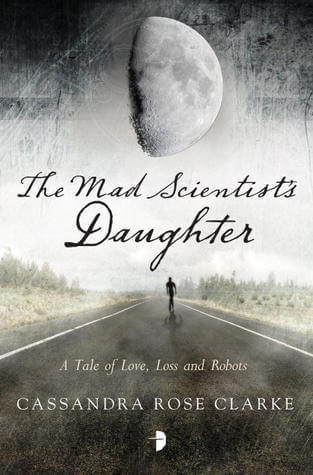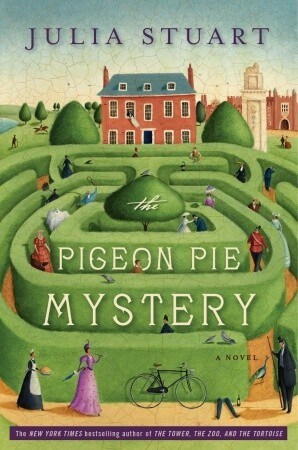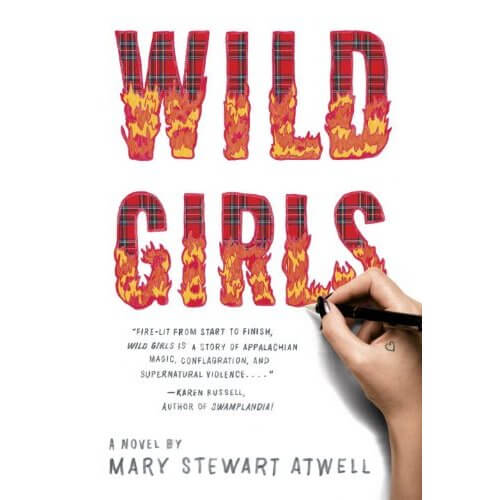The book is set in a not-too-distant future, after some unidentified troubles (which sound climate-related) have wiped out a good deal of the world’s population. Scientists created robots, sentient but subservient machines
“Finn danced better than Cat expected, and she realized, drunk though she was, that he was copying the movements of the people around him, combining them to create something new. This was always how Cat danced as well. He did it more efficiently. “
– The Mad Scientist’s Daughter, Cassandra Rose Clarke
I was talking not long ago about the phenomenon of book titles that describe the main female character in the context of her relationship with another person, usually male (The Aviator’s Wife, The Ambassador’s Daughter, and so forth). In The Mad Scientist’s Daughter, we are introduced to the titular daughter—the precocious and oft-moody Cat—and her tutor, Finn, who just happens to be the most lifelike robot ever created. As Cat grows up, her relationship with Finn changes in ways that challenge both her and societal norms.
The book is set in a not-too-distant future, after some unidentified troubles (which sound climate-related) have wiped out a good deal of the world’s population. Scientists created robots, sentient but subservient machines that are human-shaped but not made to look like real humans otherwise. These robots helped make up the lack of workers before the human population rallied itself. Now the world is back on its feet, but sentient AIs are still around and they’re raising questions of human and robot rights. Into this world comes Finn, a lifelike human replica who is intelligent and autonomous—mostly—and who is brought into Cat’s home to be her father’s “lab assistant.” He is also the young girl’s tutor, and she grows up with him as a constant presence. As she grows older, however, her feelings change, and she finds herself longing for Finn to be more than just a friend and tutor. As Cat moves on, goes to university, becomes an artist, and eventually marries a man she does not love, she and Finn engage in an illicit affair.
I wanted to so much to like this book. The premise is intriguing, a science-fiction romance promising a rich ground of ethical questions to explore: what makes a human? Does a lab-created sentience deserve the same rights as a human? Can a machine be a slave? Further, does a robot experience emotional growth and connection? Can a robot change with the people around it? How do religious groups react to AI?
Finn is the most fully realized character in the book, polite and restrained, forthright regarding what he is, yet capable of showing deep emotion—restrained emotion, but an impressive and believable range of it.
The writing is often lyrical, capturing the small wonder of a little girl catching fireflies, for example. Clarke writes artists well, describing Cat’s artistic projects and the aesthetics of the world in an evocative way. The intelligent glass house that Cat’s husband places her in is a beautiful metaphor that illustrates several of the book’s themes. The romance, too, is intriguing. Can a human and sentient robot truly love one another? Is there a difference between the programming in a robot’s circuits and in a human’s mind that causes and sustains that kind of emotion?
Unfortunately, beautiful writing isn’t enough to sustain the book. The Mad Scientist’s Daughter fell short in its quest to answer these questions or do anything more than touch on its ambitious themes. We know people look down on robots or feel resentful of them for taking jobs away from “real” people, and we know there are robots rights groups, but the discussion never moves beyond these superficialities. We know that something massive and catastrophic has taken place on earth, and yet beyond the fact that it’s too hot to go out during the day in the summer, this world that exists at some point in future is pretty much identical to our own. Cat sits in a cafe and sips lattes. She eats Japanese and Korean food. Does Japan still exist after a major global warming event? Have other geopolitical crises occurred and changed or wiped out other countries? After losing so much of the population, is it really feasible that cafes and lattes exist, and exist in exactly the same way they do now? No thought whatsoever has been put into world-building here, creating a frustratingly mundane and uninteresting view of the future. Everyone uses a “slate,” which pretty much sounds like an iPad, to communicate. Everyone uses email and IM and the internet. No interesting technology, apart from Finn and his less-evolved robot cohorts, exists. It’s almost as if we’re looking at a serious novelization of the webcomic Questionable Content (which I quite enjoy), about a bunch of twentysomethings in a modern world that’s just like ours except there are robots.
Certain elements have been added in to cause strife, but they’re never explained and they don’t really make sense. Apparently women’s roles have been reduced, and Cat’s mother who was a cyberneticist seems to have been forced to become a housewife. But Cat is encouraged to go to university and never seems in any way constrained or victimized. Have women been pushed back into this role to propagate and care for the species? It isn’t clear in any way, and if this is the case, why isn’t there far more discussion about gender roles? Cat’s father has worked with other female scientists and we know that at least one of them has a child, so how does that fit in?
Cat is herself a frustrating character. I don’t believe that you have to like and sympathize with a character, but Cat is just so deeply unlikeable. She uses Finn terribly. She uses her husband terribly. She is by turns moody, demanding, and greedy for no real reason. Because we are introduced to her when she is just a small child and are then skipped through several decades of her life, it’s difficult to connect with her or understand her in a meaningful way. By trying to cover too much of Cat’s life, we miss the chance to get to know who she really is, and we don’t get to focus on more than moments here and there, separated by many years. It leaves the book feeling flat, rather than giving the author a chance to flesh out her main characters.
The author also doesn’t take the opportunity to address a serious plot point: Finn does not change. He does not age. His thinking, it would seem, does not evolve without a software upgrade. He is exactly the same entity all through Cat’s life—an entity that has known Cat since she was little more than a toddler. There’s a serious creep factor there. If he were her father’s friend or business associate but not a robot, and he began having sexual relations with a teenager that he remembers being barely out of diapers. . . ew. But that isn’t explored here at all. The flipside, the Highlander effect as it were, is that Finn will theoretically continue to be his exact same, young-looking, unevolving self even when Cat is fifty, seventy-five, a hundred. What does that mean for Cat? For Finn?
I’m going to white out the next bit, as it does contain a major spoiler about the denouement but was too big a pet peeve to leave out. Please highlight if you would like to read: I have real difficulty with the way Cat convinces Finn of her feelings. By accessing a program he didn’t know he had and basically forcing an orgasm on him without his knowledge or consent, this scene felt shockingly close to rape to me, and yet Finn falls into Cat’s arms and sees that she has changed. This seems totally counter-intuitive: how can she prove she’s given up using him and treating him as a machine by basically punching a code into him and bringing on orgasm? Further, are we really conflating love with sexual gratification here?
I was so looking forward to this book, a story that promised to be a lush sci-fi romance, a book that could incorporate robots and romance, pose deep questions while also evoking deep emotions. Margaret Atwood’s Oryx & Crake, Charles Yu’s How to Live Safely in a Science Fictional Universe, and Hannu Rajaniemi absolutely brilliant The Quantum Thief are all examples of great sci-fi that is fun while inspiring deep thought. The Mad Scientist’s Daughter is ambitious but ultimately doesn’t go the distance, delivering beautiful writing but failing due to weak characters, meandering plot, and poor world-building.
Two out of five blue pencils
The Mad Scientist’s Daughter by Cassandra Rose Clarke, published by Angry Robot Books, © 2013
Find it at IndieBound, Amazon, Indigo, and fine independent bookstores everywhere.
You might also like:





Seems like the author wants us to believe that in the future, humanity will have progressed scientifically and technologically far enough to develop sentient robots, but it will also have stagnated socially such that women still end up marrying men they don’t love. Great.
Also, the environmentalist in me is fuming at the false assumption that coffee will be available in ample supply, and apparently easy and cheap to transport from one continent to another, after global climate change wreaks havoc on the planet.
I am sad that this one didn’t work for you. I really enjoyed it (though I agree those books you listed at the end of your review are better). And I like when books like this actually don’t answer the questions they’re posing and leave it up to me. I like to take the time to think about all the different scenarios rather than have an answer handed to me.
Thanks for the comment, Christa! See, I feel there’s a difference between posing big questions and leaving them open-ended, giving your reader food for thought, versus just not exploring the rich terrain of your narrative enough. It felt to me like the author had a great premise and just couldn’t do enough with it. There are mentions of church groups, for example, but no exploration of theology and how it conflicts with the concept of AI.
I’d have liked to see this book set just in Cat’s twenties, maybe with flashbacks or remembrances to her childhood, and with a much, much better thought-out world. Alternatively, seeing through Finn’s eyes, or through the points of view of other characters, might have made for a more compelling narrative. Because Cat is so shallow and flighty, it’s hard to get nuance here.